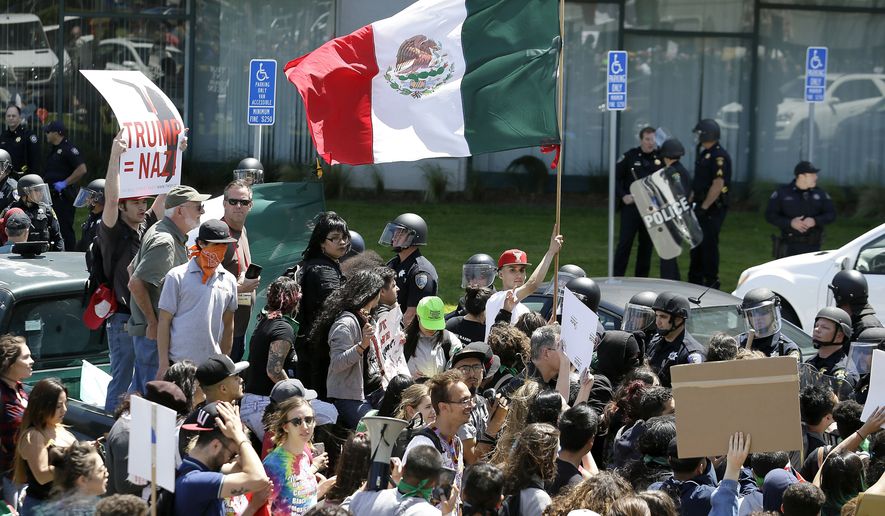Immigrant-rights advocates had vowed to make 2016 the year of the anti-Donald Trump citizenship surge, hoping to sign up a million new immigrants eager to send a message rejeting the GOP’s presidential candidate — but so far they’re falling short, with naturalization rates only slightly higher than four years ago.
There’s little question that Mr. Trump’s outsized rhetoric has angered Hispanic activists overall, and Mexican immigrants in particular. But applications for citizenship are up just 6.6 percent compared to the same period in 2012, according to the latest data from U.S. Citizenship and Immigration Services, and actual approvals are down slightly.
Groups say the numbers don’t jibe with the intensity they’re detecting when they hold citizenship workshops, and they’re hoping when all is said and done, the numbers will be higher.
“I certainly don’t have a crystal ball but what we’ve seen on the ground is that there’s strong anecdotal evidence that suggests people are turning out in bigger numbers this year,” said Tara Raghuveer, deputy director at the National Partnership for New Americans, which is leading a push for naturalizations.
“We saw unprecedented turnout at our events across the country We feel that the effect of the political climate is real and will have real effects on the naturalization numbers,” she said.
Nearly 9 million people in the country are eligible for citizenship but haven’t yet applied, providing a deep bench for the activists to target.
Of those eligible, about one-third are Mexican — a pool that activists said are particularly enraged at Mr. Trump, after he kicked off his campaign last June by saying Mexico sends rapists and other bad elements of its society to the U.S.
Mr. Trump has also vowed to build a wall along the U.S.-Mexico border and force the Mexican government to cough up the money for it. And more recently he has called a U.S. judge hearing a case on Trump University biased because of the judge’s Mexican heritage — a claim that even fellow Republicans have deemed “racist.”
Hispanic-rights groups insisted voters will punish Mr. Trump for his attacks, and anecdotes abound of Hispanic voters saying they’re eager to send a message to him.
But the latest controversy may not end up mattering much, at least when it comes to pushing immigrants to become citizens. That’s because USCIS says it generally takes at least five months to process a citizenship application, and with the election slightly less than five months away, the unofficial cut-off date is already gone.
April and May figures have yet to be released, but through the first three months of this year, 252,254 immigrants submitted citizenship applications, and USCIS approved 177,713. During the same period in 2012, the totals were 238,065 applications submitted and 179,548 approved.
To become a citizen, an immigrant usually has to have been a legal permanent resident for five years, and then must pass the citizenship test. There are exceptions to the wait for those who serve in the military, and exceptions to the citizenship requirements based on age.
Groups haven’t given up hope of a bigger surge from April and May.
“We’re going to need to see what happens when it’s all over. We’re keeping our eye on it,” said Rosalind Gold, senior director of policy at the NALEO Educational Fund, which advocates for Latino causes.
The record year for new citizens was 2008, when 1,046,539 people took the oath of office. By contrast, in 2012, the last presidential election year, 757,434 people were sworn in as new Americans.
The 2008 surge was due in large part to a rush to beat a massive spike in the application fee. A smaller hike is pending now, which could help boost numbers this year.
The Obama administration is also trying to ease the process, announcing a major push to get folks to sign up. About one-third of those already eligible to be citizens would qualify for a fee waiver, and the administration has told activists it’s moving personnel around to try to handle applications quickly.
Once they’re citizens, it will be up to the campaigns and activists to register them to vote, then get them to turn out on Election Day. That’s true for both new citizens and Hispanics born here.
Hispanics traditionally vote at far lower rates than other groups — but newly naturalized Latinos do turn out in higher percentages than those born in the U.S, Ms. Gold said. That’s particularly true in the key battleground state of Florida, where in 2012 just 60.6 percent of non-Hispanic citizens voted, but 68.7 percent of naturalized Latinos turned out.
“We are going to be watching how the candidates reach Latinos, work to engage Latinos,” Ms. Gold said. “I think we’re also going to be looking at as the election gets closer, whether some of the momentum that’s built up in the primaries sustains itself through the general election.”
Before the judge flap, Mr. Trump’s support among Hispanics ranged from an embarrassingly low mid-teens all the way up to more than 30 percent of the vote, depending on the poll — a massive margin of error that hints at both the difficulty of polling Hispanics, and the controversy Mr. Trump has spawned.
• Stephen Dinan can be reached at sdinan@washingtontimes.com.




Please read our comment policy before commenting.